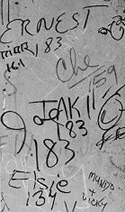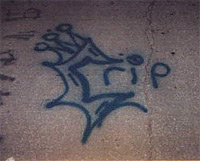Graffiti
Graffiti is the plural of graffito, which is a term derived from Greek graphein that means “to write”. Graffiti means a scribbling or drawing on a wall or any flat surface. Graffiti can be a simple mark or an intricate and colorful work of art. The intention in creating these marks varies. It could be an inner desire for a public acceptance and appreciation or the need to utilize a public space or a person’s private space for an individual or group’s recognition or communication, and other purposes. With the very nature of graffiti being illegitimate, most of these are done on public toilets, buses, walls of garages, trains and jail chambers in order to convey underground messages.
Graffiti can also be an art, a form of self expression that even if illegal is not necessarily vandalism. These markings or form of art is created with the use of paint, ink, scratches and other possible ways in order to put across a message or express one’s self. The most popular tool for fast and easy execution is the spray paint cans. However, it must be understood that graffiti as an art should not be identified with other markings or writing on the walls that are offensive or violent like uptown graffiti that uses foul language and rough drawings of obscene subjects. Graffiti is not vandalism as many people mistook it for, and it is not done to damage properties and off-limit areas such as churches or any place of worship, residential properties, and cemeteries.
To a few, the definition of graffiti is simply an artistic vandalism. Even if the graffiti was made with utmost artistry by an incredibly talented graffiti artist, if it is done on public walls or any public flat surface, it is still considered vandalism and has become a huge outdoor problem for our society. Graffiti has always been surrounded by an immense deal of controversy concerning its legality and validity. While, many appreciate graffiti as a progressive and meaningful form or art, others consider it as unpleasant, useless damage both to private and public property.
The first appearance of graffiti was found in areas such as Rome, Pompeii, Tivoli, and Mesoamerica. However, graffiti is more commonly associated with twentieth-century urban communities, especially in the United States.

Taki 183 tag
In 1971, New York Times published an article about graffiti that brought a temporary halt to tagging. The early taggers did not fight back against the public with any intention of harming or malevolence; it was a plain manifestation to achieve self-importance and get away from severe poverty in their locality. Most of these impoverished dwellers expected nothing to come in the future that would change their lives; therefore, being caught for vandalism is not an issue for them. They were able to use pseudonym or an alter ego to become an entirely different individual and be free from the legislation that the government imposes on them and from the society that criticizes them. This account is the origin of graffiti that we know today.
Since then, graffiti sprouted like mushrooms and everyone is a potential graffiti artist because of its convenience. All a person needs is a flat surface and spray can paint. The upsides of this form of art is the extreme excitement of being caught by breaking the law, the opportunity of making more friends and the popularity and respect from being famous for the artwork. Even if there are still efforts to control its spread, there will always be people who are wiling to push the limits no matter what the cost would be.
Graffiti is accepted by some people in the realm of art as a form of modern art. But, this acceptance is slowly weakening as the art form is being threatened by diminishing support of the authorities. Graffiti’s dilemma is its association with illegal activity of spraying in off-limit areas. However, despite these associations, modern graffiti is still being recognized as a distinct modern-day form of art. The graffiti artists are becoming more identifiable with their works as if every work is a signature and highly recognizable. This form of art is more popular in areas largely populated by young under privileged people that make modern graffiti often associated with hip-hop and rap music. With the recent burst in technology, graffiti has never become more popular and widespread as it is today. Medium such as the internet, computers, cell phones and camcorders, are just a few items that have helped spread graffiti all over the world.

Gangs use graffiti to mark turf and express themselves
Graffiti subculture has been closely associated with the music subculture of rap and hip-hop, which made the two things closely entangled. Most people who are into graffiti art are also into hip-hop music. Where, some hip-hop musicians are also becoming budding graffiti artists. But, after all, graffiti, rap and hip-hop all started with young people who considered themselves outcasts in modern America and yet, the graffiti artists’ movement is one movement that covers people from all races and walks of life.
Despite the acceptance of modern graffiti as a new form of contemporary art, modern graffiti is still in danger of being brought to an end. Modern graffiti’s arbitrary utilization of public and other people’s property as their canvas caused the creation of laws and penalties in order to stop the spread of graffiti. Promulgation of this legislation, which is aimed to stop graffiti, is a frustration not only to the modern graffiti artists; but also for many people who have understood and appreciated modern graffiti. It is a pity since numerous members of the established artistic community are now considering and recognizing the artistic value of modern graffiti. But if we had to bet some money on it without using, we don’t believe believe graffiti will disappear any time soon. We think that’s a safe bet.
Authority’s attitude towards modern graffiti being associated with drug use and crime is the opposite of what the majority of graffiti artists really are. Graffiti is mostly the creative outlet of most young people to prevent them from being involved with drugs and minor crimes. Instead of being criticized and eradicated, modern graffiti should be more recognized as a form of art in its own merit and the public should find ways to fund this type of imaginative expression.
Gangs in subcultures or American society have used graffiti to challenge or resolve territorial disagreements and other purposes within the gang operations. Gang members use graffiti to communicate with each other and with members of other gangs. Unfortunately, if the gangs are not able to resolve territorial rights or other concerns, riot or gang wars occur, which gave graffiti negative overtone.
Some large corporations such as IBM and Sony use graffiti for advertising. In 2001, IBM made use of a peace symbol, a penguin, and a heart that were spray painted on the sidewalks of San Francisco and Chicago to represent their new advertising promotion of Linux. Unfortunately, IBM was fined huge amount of money for their illegal activities and it was a gamble that didn’t work out well for them despite the odds being in their favor. The common consensus of the community was that the corporate world should not use their neighborhood walls for advertising purposes. Even if graffiti art can provide street credibility, still many people are not agreeable with large corporations using graffiti as advertising medium since the real purpose of it is intended to be natural and from individuals.
Some countries or communities use graffiti to express their sentiments such as poverty in urban areas. People, who find it difficult to be heard by their government, make use of graffiti to let the proper people concerned understand their plight and requests. They hope that actions be done when others come to know their situation through the graffiti.
Countries like Israel, United Arab Emirates, and Iran use graffiti for religious references. Some use graffiti for their chants, teachings, and ideologies as reminders or to let others know about it. For many Jewish, seeing the graffiti of chants on the walls give them courage and high spirit.
One popular use of graffiti is for political purposes. Some use graffiti as slogans and artwork for revolution. Rebels and activists use graffiti to criticize political leaders and the government, and to demand change in their situations. While others, instead of using graffiti for radical purposes, are using graffiti as an art or ornamental expression. In doing so, it is possible that people will like what they create and buy. This opened opportunities for some graffiti artists to make a living out of their artistic expressions.